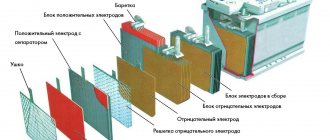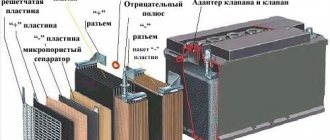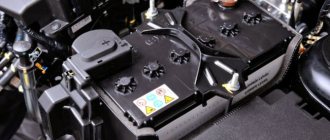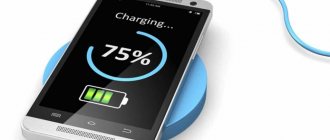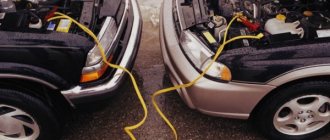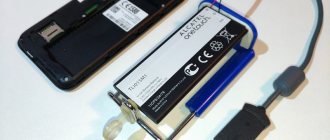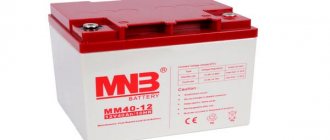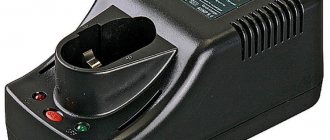Methods of connecting two batteries: series and parallel
A fairly large number of hunters, fishermen and travelers, due to their hobby, often install an additional battery on their vehicles. This is necessary so that the energy of the main battery is conserved, and in the future you can leave the location without incident.
There are many areas of application for a second battery:
Why is a second battery needed?
There are many areas of application for a second battery:
- Ensuring the operation of additional electrical appliances necessary for a comfortable pastime in nature (for example, such as a refrigerator, lighting fixtures, musical equipment).
- A vehicle equipped with an electric winch must in any case be equipped with a peripheral battery.
- Executive class vehicles are, by default, equipped with a video player, TV, coffee maker, microwave and other electrical appliances that provide increased comfort when traveling.
- Security video surveillance systems, anti-theft systems, all kinds of radio alarms, as well as devices designed for active vehicle protection, must also be equipped with their own separate battery.
How to properly connect two batteries?
To successfully carry out this operation, you should follow the following tips:
So, by trying to follow these recommendations, you can make your leisure time in nature, fishing, hiking or hunting truly colorful and unforgettable.
However, you need to decide on how to connect the two batteries to each other.
The first method : serial connection: a jumper is placed over the terminals: its own jumper for the “negative”, its own jumper for the “positive”, then the remaining two “opposite” terminals of the two batteries are connected to each other, and the “positive” and “negative” wires are connected to the rest of the vehicle's electrical system.
Second method : parallel connection: with this type of connection of two batteries, the jumper is placed as follows: the “negative” and “positive” terminals of the batteries are connected, then wires are removed from the paired batteries, which are connected to the rest of the vehicle’s electrical system.
After the batteries have been connected to each other, you should install either a switch or a switch between them.
This step will allow you to use the energy resource of only one battery. For example, when the engine is turned off, the car lights or audio system will work.
If the vehicle's engine is turned on, the energy required to operate electrical appliances in the car is generated by a special generator. But, the truth is, fuel in a vehicle is wasted much more, and this, in turn, leads to incredible fuel costs.
Conclusion
Summarizing the above, it is worth saying that installing a peripheral battery in a car will be the best solution. Now you don’t have to worry about sudden battery discharge and subsequent problems getting a spark for ignition.
But the second battery will only be effective if it has been installed and connected to the first in accordance with generally accepted recommendations and standards. Incorrectly connected batteries will become a real headache for the car enthusiast. When choosing a battery, you need to focus not only on the size, capacity and brand, but also clearly understand the purpose of the battery and its scope of application. For example, there are starter and traction batteries designed for different purposes.
Write comments, additions to the article, maybe I missed something. Take a look at the site map, I will be glad if you find anything else useful on my site.
Share link:
Similar
Soft starters
Gas analyzer
How to choose an exhaust system for the kitchen?
12 thoughts on “Connection diagram for two batteries”
moron... the battery is a bank of batteries connected in series... the banks can be connected in parallel
By connecting two batteries in parallel, the current in AH does not increase; if you take two batteries of one hundred AH each and connect them in parallel, the same amount of 100 AH will remain, but in series it will increase by one revolution, as well as the voltage itself. You can also make the UPS independent of an external power source.
Those. do you teach people to connect batteries just like that, without any connections? )))
People, don’t even try to repeat these simple solutions! 2 batteries must be decoupled from each other.
Brad wrote. With a parallel connection, the voltage (volts) remains unchanged, the inrush current (amps) and capacity (amps/hour) will increase. Learn physics at least at a basic level, or at least connect two batteries and measure the current. And so, connect two IDENTICAL NEW batteries without isolation and don’t worry. Many older cars have this system from the factory.
Connecting batteries either in parallel or in series is possible, but be careful. Sergey, you don’t want to go even deeper, otherwise you showed off your intelligence but didn’t get to the point, the author took the battery as 1 unit, and not its components. So 2 batteries are 2 units of batteries, and not 12 (figuratively) containers with positive and negative plates, an electrolyte separator and 10 jumpers. Oleg Evgeniy wrote to you correctly, before speaking, read physics and test it yourself. Dima, you’ve never been “LIGHTED.” Are they making a decoupling for you or is everyone carrying a “Ura 200” block with them. It is possible and sometimes even necessary to connect the batteries this way, taking into account their wear first of all, if for everyday use I agree with Dmitry, it is better to decouple them with at least 100A diodes.
Why connect batteries into a battery
In any electrical systems or devices there are ohmic losses: part of the electrical energy is converted into heat without producing useful work. The higher the voltage of the electrical system, the lower (with the same power) the current, the lower the ohmic losses and the lower the price of the system. Those. It is beneficial to have high voltage electrical systems. Moreover, the greater the power of the system, the greater the gain of the high-voltage system compared to the low-voltage one. Therefore, small UPS (several hundred VA) usually have one 12-volt battery (this is cheaper), a UPS with a voltage of several kVA uses a battery with a voltage of tens of volts, and in powerful UPS with a voltage of tens of kilowatts, the battery voltage can exceed 500 V .
Therefore, the purpose of using batteries with series connection of batteries is to reduce losses and increase efficiency.
Sometimes the capacity of one battery is not enough, and you need to increase the capacity. Sometimes it is more convenient not to replace a battery with a larger capacity, but to place another one of the same battery in parallel, so that the total battery capacity of the battery doubles.
For example, to increase the operating time of a high-quality Eaton Powerware 9130 UPS from a battery, one or more of the same batteries are connected in parallel to the existing battery.
Connecting a second battery to the car
The purpose of the battery is to ensure that the car starts while driving, and to feed the consumers of the on-board network using a generator-battery tandem. But modern cars are equipped with additional devices. Their total power at times exceeds the capabilities of the power unit. As a result, the battery runs out and cannot start the engine. There is a need to install a second battery in the car.
Instructions for connecting 2 batteries
Whether you use a parallel connection for longer runtime or a serial connection for faster speeds, make sure you follow these guidelines:
Set the appropriate gear ratio (piñon spur)
Refer to your model manual and follow the recommended gear ratio for dual battery operation. The instructions may contain information about installing the pinion for high speed driving. Use this setting ONLY for riding on hard, level surfaces. Avoid repeated accelerations to prevent excessive stress on the engine, ESC and batteries.
Control the temperature
When operating a model with two batteries, make sure that the speed controller and the engine do not overheat. Stop the model and allow it to cool if the overheat protection is activated by the speed control or the engine temperature exceeds 90°C. (TRA4091 temperature sensor is a useful accessory for monitoring engine temperature)
Increasing weight affects handling
The additional weight of the second battery and connector affects the handling and performance of the model. Road models actually perform better with two batteries, as the extra weight improves grip and handling. Off-road models may require stiffer springs, as the extra weight of the battery can cause the suspension to “pop” during hard jumps and landings (additional stiffer springs are listed in bold in the manual among the parts included with your vehicle).
Using two LiPo batteries
Traxxas 1/16 VXL models equipped with the VXL-3m speed controller can be used with 2S LiPo TRA2820 and 3S TRA2823 batteries. You must enable the low voltage detection feature before installing LiPo batteries. LiPo batteries can be installed in a dual battery configuration using only the TRA3064 parallel connector. DO NOT use the daisy chain connector with LiPo batteries. This will lead to overload of the speed controller and possible failure. If you decide to install two LiPo batteries, it is recommended to use a pinion that is two teeth smaller than what was originally installed on the model. This will prevent the electronics from getting too hot due to the long runtime you'll get from using a pair of LiPo batteries.
Traxxas 1/16 manifold models are equipped with an XL-2.5 speed controller, which has a built-in low voltage detector. This means it can handle 2S LiPO batteries. Be sure to check the temperature of your motor, as the extended run time achieved with LiPo batteries can cause the motor brushes to overheat and fail.
| If you still have questions after reading this article, feel free to call +, or write – [email protected] , come to us! Our managers and salespeople will be happy to answer and advise on any questions, and the service specialist will provide technical support. Waiting for you! |
How to connect a second battery in a car
The problem of finding a place for an additional device is often solved by using the trunk. You should not use niches under the seats in the cabin - emissions from a working battery are harmful.
The issue of restoring the charge in the second battery in the car should be resolved. The generator is designed to work in tandem with one battery of a certain capacity. Connecting a second battery overloads the generator. You can charge the second battery from the mains, but this is inconvenient. This means that it is necessary to find a way to power the assistant from the on-board network without shortening the service life of the generator.
Ways to connect two sources:
Parallel connection of a second battery
This method of connecting two batteries in a car is considered the simplest. To do this, the same poles of both batteries are connected. However, there may be some problems with this connection.
General automotive equipment, as well as additional consumers, are powered by a standard battery. In other words, the transfer of electrical energy occurs from the second battery to consumers, using only one main battery.
The energy of the standard battery is consumed first, then the discharge is replenished from an additional battery. Recharging takes a long time. Moreover, it must be remembered that the transfer of energy by the second battery occurs until the charge on the batteries is equalized. It turns out that the car has two batteries, and both are only 50% charged.
To correct this situation, engineers have developed a special automotive circuit for connecting a second battery. For this purpose, a diode insulator is installed.
How to connect a second battery in a car
Often, installing a second battery in a car solves several problems: separate power supply for household appliances and doubling the current to the winch. But there is only one generator. How to connect a second battery? By connecting the batteries in parallel, we will force the generator to supply double the current to the network. One battery can parasitize at the expense of another, taking more charge. The batteries may drain evenly, preventing the starter from starting.
1.Using a separation controller when connecting a second battery to the car will allow you to charge the battery one at a time and use the charge rationally. Switching devices represent switches of various designs. An example is battery decoupling devices (BIDs), the most popular being URA 200. Using this device, you can use double energy when operating a winch or starting the engine in winter.
2. The kit for installing a second battery includes a semiconductor resistor. The connection via a diode isolator separates the power supply from the vehicle’s on-board network and additional household systems. During periods of inactivity, the additional battery will be discharged, supporting the operation of gadgets. The main battery remains ready to start the engine. But while driving, the generator recharges both batteries. In order to use the second battery in the main circuit, it will need to be moved to the main socket.
3. The most rational connection diagram for the second and subsequent batteries is developed with the installation of a charging switch. The device can be manual or automatic, but one battery is always charged from the generator. The charge level of all batteries is displayed on the control panel. The driver has a choice of what is the priority at the moment: music, air conditioning or the willingness to winch.
There are cars where the manufacturer has provided the circuit and installation of a second battery. But more often you have to create comfort in the car with your own hands.
When is a second battery required?
Among those who will need to install a second battery, we can immediately highlight SUVs with electric winches. Increasingly, you can find additional electrical equipment in cars: a refrigerator, a heater, a laptop, DVD players, a microwave oven and even a coffee maker. In addition, anti-theft systems, alarms, and radio channels are attached to the long-suffering battery. A powerful sound system in a car is a topic for another discussion.
If the generator generates electrical energy while moving, then somewhere on a picnic, after listening to music, you can stay there. The battery is not strong enough to start the engine. Carry another battery with you? Yes, but it needs to be charged periodically. In addition, we only remember about it when the main battery has died. If your car’s battery runs out quickly due to a large number of consumers, then you can’t do without a second battery.
How can you figure out whether you need an additional car battery? Let's consider the situation using the example of an average car with a battery with a capacity of 60–65 Ah. The approximate power of such a battery is about 4 kW. At the same time, the regular energy consumers in the car have a power of about 2 kW.
Thus, if you are installing additional devices in your car, which in total will have a power of more than 2 kW, you should think about installing a second battery. You can estimate the power consumption of devices from their passport data.
Some features of batteries
The classic battery is a car lead-sulfate battery. Available in the form of batteries connected in series to a battery. Its use and charging/discharging are well known. Their dangerous factors are caustic sulfuric acid, which has a concentration of 25-30%, and gases - hydrogen and oxygen - that are released when charging continues after it has chemically ended. The mixture of gases resulting from the dissociation of water is precisely the well-known explosive gas, where there is exactly twice as much hydrogen as oxygen. Such a mixture explodes at any opportunity - a spark, a strong blow.
Batteries for modern equipment - mobile phones, computers - are made in miniature versions, and chargers of different designs are available for charging them. Many of them contain control circuits that allow you to monitor the end of the charging process or charge all elements in a balanced manner, that is, disconnecting from the device those that have already been charged.
Serial connection of sources
This is a well-known battery made of elements, “cans”. In series - this means that the plus of the first is brought out - there will be a positive terminal of the entire battery, and the minus is connected to the plus of the second. The minus of the second is with the plus of the third. And so on until the last. The minus of the penultimate one is connected to its plus, and its minus is brought out - the second terminal of the battery.
When the batteries are connected in series, the voltage of all the banks is added up, and at the output - the plus and minus terminals of the battery - the sum of the voltages is obtained.
For example, a car battery, having approximately 2.14 volts in each charged bank, gives a total of six banks of 12.84 volts. 12 of these cans (battery for diesel engines) will provide 24 volts.
And the capacity of such a connection remains equal to the capacity of one can. Due to the fact that the output voltage is higher, the rated power of the load increases and energy consumption will be faster. That is, everything will be discharged immediately together as one element.
Such batteries are also charged in series connection. The plus of the supply voltage is connected to the plus, and the minus to the minus. For normal charging, it is necessary that all banks have the same parameters, from the same batch and are equally discharged.
Otherwise, if they are discharged slightly differently, then when charging one will finish charging before the others and will begin to recharge. And this could end badly for him. The same thing will be observed with different capacities of the elements, which, strictly speaking, is the same thing.
Series connection of batteries was tried from the very beginning, almost simultaneously with the invention of galvanic cells. Alessandro Volta created his famous Voltaic column from circles of two metals - copper and zinc, which he arranged with rags soaked in acid. The structure turned out to be a successful idea, practical, and even provided a voltage quite sufficient for the then bold experiments in the study of electricity - it reached 120 V - and became a reliable source of energy.
Series connected batteries
For batteries connected in series, the voltage increases, but the capacity remains the same.
Two 12-volt batteries connected in series are charged with a 24-volt charger
When connected in series, the batteries must be of the same type and age. The capacity and manufacturer must also be the same. If one of the batteries has been used before, then most likely its capacity is already less than nominal and during charging it will be charged first. But the charger may not “notice” this and will try to fully charge the remaining ones. The temperature and pressure in the old battery case will increase. Gas will begin to be released, and the active material of the plates will begin to deteriorate.
Under load, the wear of the old battery will increase. After the weak cells have used up their charge, the good ones will continue to produce current. The voltage across the discharged cells will drop to zero, and then their polarity will reverse (this most often happens in large batteries). An uncontrollable increase in pressure and temperature will follow and a catastrophe will occur.
Parallel connection of batteries
When connecting power supplies in parallel, all the pluses must be connected to one, creating the positive pole of the battery, all the minuses must be connected to the other, creating the minus pole of the battery.
With such a connection, the voltage, as we see, should be the same on all elements. Just what? If the batteries have different voltages before connection, then immediately after connection the “equalization” process will immediately begin to occur. Those elements with lower voltage will begin to recharge very intensively, drawing energy from those with higher voltage. And it’s good if the difference in voltage is explained by different degrees of discharge of identical elements. But if they are different, with different voltage ratings, then overcharging will begin, with all the ensuing delights: heating of the charged element, boiling of the electrolyte, loss of metal from the electrodes, and so on. Therefore, before connecting the elements together into a parallel battery, it is necessary to measure the voltage on each of them with a voltmeter to ensure the safety of the upcoming operation.
As we can see, both methods are quite viable - both parallel and serial connection of batteries. In everyday life, we only need those elements that are included in our gadgets or cameras: one battery, or two, or four. They are connected as determined by the design, and we don’t even think about whether it is a parallel or serial connection.
But when in technical practice it is necessary to provide a large voltage at once, and even over a long period, huge fields of batteries are built in the premises.
For example, for emergency power supply of a radio relay communication station with a voltage of 220 volts during the period when any emergency in the power circuit must be eliminated, it takes 3 hours... A lot of batteries.
Do you have to use the jumper battery's energy in anything other than starting the engine? If yes, then you are putting yourself in danger. Miss the moment when the battery voltage drops below a critical level and you will find yourself immobilized in the middle of a pond. All you have to do is call the shore for help or rely on a passing ship.
It is much more reasonable to install an additional battery, connect on-board equipment to it and safely use a heater, refrigerator, echo sounder or music system both on the go and when parked. But before you do this, you need to decide how to charge both batteries


